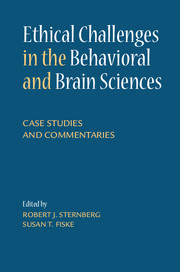Book contents
- Frontmatter
- Contents
- List of Contributors
- Preface
- Part I Academic Cheating
- 1 Beyond the Immediate
- 2 Collaboration, Cheating, or Both?
- 3 Grappling with Student Plagiarism
- 4 Commentary to Part I
- Part II Academic Excuses and Fairness
- Part III Authorship and Credit
- Part IV Confidentiality’s Limits
- Part V Data Analysis, Reporting, and Sharing
- Part VI Designing Research
- Part VII Fabricating Data
- Part VIII Human Subjects
- Part IX Personnel Decisions
- Part X Reviewing and Editing
- Part XI Science for Hire and Conflict of Interest
- Epilogue Why Is Ethical Behavior Challenging?
- Index
3 - Grappling with Student Plagiarism
Published online by Cambridge University Press: 05 February 2015
- Frontmatter
- Contents
- List of Contributors
- Preface
- Part I Academic Cheating
- 1 Beyond the Immediate
- 2 Collaboration, Cheating, or Both?
- 3 Grappling with Student Plagiarism
- 4 Commentary to Part I
- Part II Academic Excuses and Fairness
- Part III Authorship and Credit
- Part IV Confidentiality’s Limits
- Part V Data Analysis, Reporting, and Sharing
- Part VI Designing Research
- Part VII Fabricating Data
- Part VIII Human Subjects
- Part IX Personnel Decisions
- Part X Reviewing and Editing
- Part XI Science for Hire and Conflict of Interest
- Epilogue Why Is Ethical Behavior Challenging?
- Index
Summary
Some years ago, I was grading final papers for a seminar I teach on the psychology of prejudice, and I noticed an usually eloquent passage from a student who was not an especially strong writer. At first I was impressed with the poetic quality of the passage, but the more I thought about it, the less sure I was that this particular student could have written it, so I searched the web and found that the student had used a professional writer’s material without attribution – a clear instance of plagiarism.
In the case study that follows, I’ll describe my three-part response and conclude with a few words about why my response fell short of a comprehensive solution.
Part 1: The student. After discovering the act of plagiarism, I promptly emailed the student, pointing out that sections of her paper matched unattributed sources verbatim and constituted plagiarism . I then asked her to email me a list of all passages taken directly from other people’s work, along with a citation or web address for each original source. I also wrote that even though I had provisionally given her a score of zero for the paper, I hoped that there was a simple explanation for what I found, and I assured her that I was fully committed to handling the problem as fairly as possible.
- Type
- Chapter
- Information
- Ethical Challenges in the Behavioral and Brain SciencesCase Studies and Commentaries, pp. 8 - 10Publisher: Cambridge University PressPrint publication year: 2015

